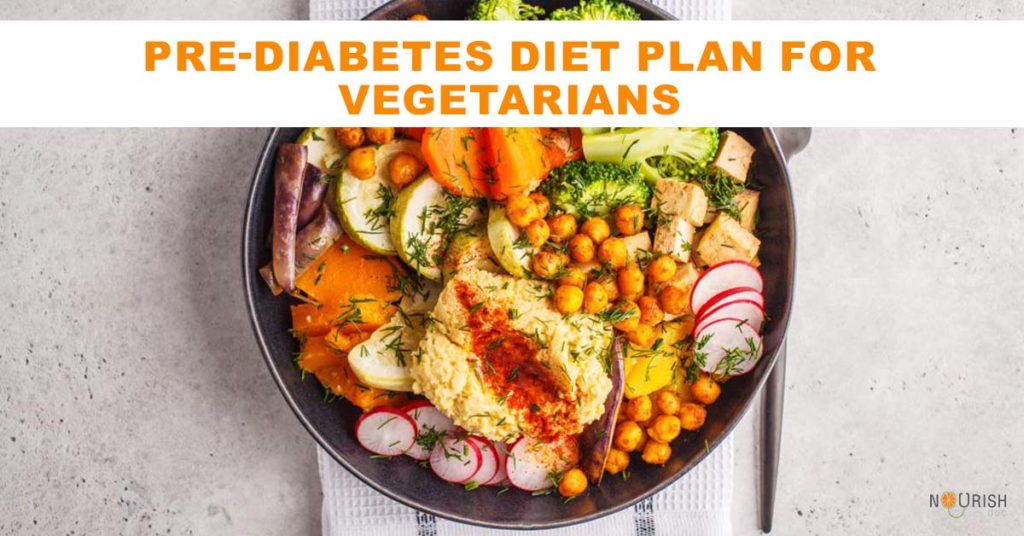How This Helps
The nutritional guidelines of eating healthy for a pre-diabetic mainly includes eating a fiber rich diet containing complex carbohydrates from unprocessed/minimally processed cereals, whole pulses, legumes, colorful fruits and vegetables and healthy fats from nuts, seeds and oils. The portion size of each food consumed is important, because it has an impact on the blood glucose level. In a pre-diabetic’s diet, out of the total calories, 55-60% should be made of complex carbohydrates, 15% protein and 25% fat. Refined sugars and processed foods are best to be avoided.
Science and Research
Pre-diabetes can simply be defined
as a condition where blood sugar levels are higher (i.e. fasting blood sugar is
100-125mg/dl) than normal but not high enough to be classified as Type 2
diabetes. It is like a red flag or a warning sign to caution that a pre-diabetic
is vulnerable to develop Type 2 diabetes. But the good part is, he/she can take
the following 3 simple yet vital steps to prevent the development of Type 2
diabetes:
1. Eating healthy meals
2. Exercising regularly
3. Losing weight, if overweight and
maintaining the lost weight
Characteristics for Pre Diabetes
Dies Plan:
This is a sample vegetarian
pre-diabetes diet plan that provides 1400 kcal and 50g protein which consists:
No. of Servings Food Group Amount per serving
5 Cereals
30g
2 ½ Pulses/Dals
30g
3 Low fat
milk and milk products 100g
3 Non-starchy
Vegetables 100g
2 Fruits
50g
½ Nuts
and seeds 15g
3 Cooking
Oil 5g
Below given is a one-day sample
Indian vegetarian meal plan for pre diabetes that is of 1389 calories, 52g
protein, 202g carbohydrate, 35g total fat and 23g dietary fibre:
See: Type 2 Diabetes Meal Plan for a Day
• On empty stomach – Roasted
black cumin seeds
Dry roast or microwave black cumin
seeds until you get a bland taste. Take ½ teaspoon in the morning on empty
stomach. (Can either be taken in the powdered or whole seed form)
Per Serving: Serving size (1
teaspoon-5g), 18 calories, 0.9g protein, 1.8g carbohydrate, 0.7g total fat,
1.5g dietary fiber.
Nutrition Fact:
Black cumin seeds also known as
black onion seeds/kalonji in hindi (Botanical name- Nigella Sativa) has shown
strong evidence in reducing blood glucose levels. The most active compound
called thymoquinone present in it is known to trigger insulin production in the
pancreas and improve its sensitivity, thus increasing glucose absorption by
cells and in turn reducing glucose levels in the blood stream.
• Breakfast – Whole green gram
savoury pancakes (pesarattu) with ginger chutney
http://indianhealthyrecipes.com/andhra-pesarattu-whole-moong-dosa/
Per Serving: Serving Size 2nos.
(Recipe serves 7) 148calories, 7g protein, 17g carbohydrate, 5.4g total fat,
5.3g dietary fiber
See: Type 2 Diabetes Meal Plan
Nutrition Fact:
Whole green gram is a good source of
low-fat protein rich food. The high fiber content in whole green gram slows
digestion and absorption of carbohydrates that stabilizes blood sugar levels.
It is a wholesome ingredient that is also rich in essential micronutrients like
B-complex vitamins, Vitamin C and minerals.
Ginger has potent bio-active
compounds that contribute to its anti-inflammatory and anti-oxidant properties.
Recent researches have shown evidences that it plays a role in controlling
elevated blood sugar and cholesterol levels.
• Midmorning Snack – Pear
(Optional – can add 1 teaspoon
unsweetened peanut butter)
Per Serving: 1 medium sized (100g)
52 calories, 0.6 protein, 11.9 g carbohydrate, 0.2g total fat, 4.3g dietary
fiber
Nutrition Fact:
Pear is a juicy low-glycemic fruit
rich in dietary fiber both soluble and insoluble fibre, that keeps blood sugar
levels under check. It is also rich in anti-inflammatory flavonoids and
antioxidants that engulf the free radicals and reduce body’s oxidative stress.
•Lunch – Vegetable Oats bisi belle bhaath and buttermilk
http://indianhealthyrecipes.com/oats-bisi-bele-bath-sambar-oats-recipe/
http://www.foodnetwork.com/recipes/emeril-lagasse/homemade-buttermilk-recipe.html
Per Serving: Serving Size 1 cup
(Recipe serves 2) 446 calories, 18.3g protein, 61g carbohydrate, 14g total fat,
3.6g dietary fiber
Nutrition Fact:
Oats is a nutritious ingredient that
has a beneficial effect on the glycemic control and insulin sensitivity due to
its active soluble fiber compound called β-glucan. It is backed by strong
evidence in controlling blood sugar levels.
Dals or lentils used in the recipe
is a rich source of protein. When it is combined with a cereal or whole grain,
the quality of protein is enriched and favors the absorption of protein
Buttermilk is made from curd, and is
an excellent source of probiotic that maintains gut micro-flora and aids in
digestion. It has a low glycemic index and is also a good quality protein.
• Evening Snack 1 – Khakra
Canapés
Per Serving: Serving Size 3-4
khakras (Recipe serves 4) 235 calories, 8g protein, 48g carbohydrate, 1g total
fat, 1.4g dietary fiber
Nutrition Fact:
Khakras are mostly popular in the
western region of India. It is a form of Indian bread called roti that is made
of whole wheat flour and is dry roasted on a pan until the bread turns crispy.
It is a low calorie, low fat tangy wholesome, light snack option which can be
consumed directly or can be made more nutritious by adding colorful vegetable
combinations with a dash of yogurt on it. It is rich in fiber an
See: Type 2 Diabetic Meal Plan Ideas







